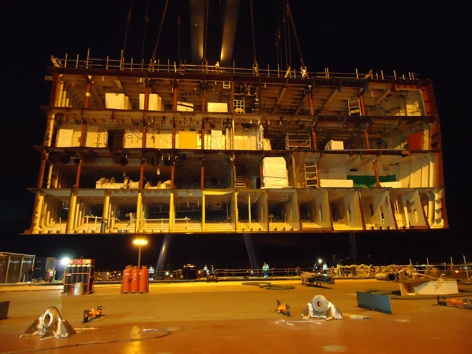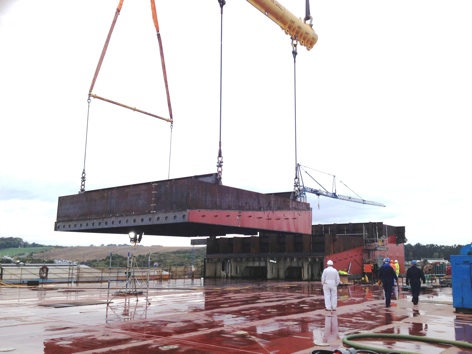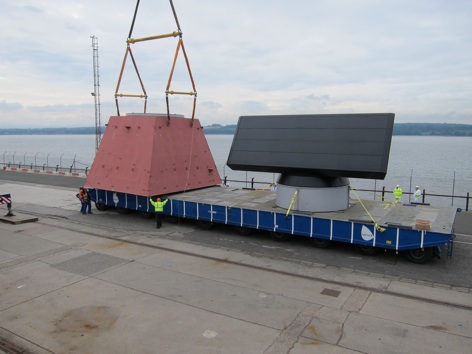On September 26th the 450 tonne sponson block SP11 was lifted into position at the stern of HMS Queen Elizabeth by the Aircraft Carrier Alliance’s Goliath Crane at Rosyth.
Every single lifting operation, using the largest capacity crane in the UK, has been carried out safely with no injuries or incidents. In fact all of them have been carried out on or ahead of the schedule that was set at the start of the manufacturing phase five years ago. This is a really great achievement and is a tribute to all the hard work done in engineering the lifting arrangements, rigging the crane and the meticulous planning that went into each lift.

With the hull structure now complete the ACA teams are progressing all the activities that are required to allow flood up of the dock and float out of the ship in the middle of next year. This includes finishing off all the work in the tanks, painting the hull surfaces and installing the shaft lines, propeller hubs and rudders.
The operation to remove the supports under the hull and transfer the weight of the ship onto the skeg has completed successfully. This operation known as “drop stern” allows the hull to take up the shape it will have when afloat and enables an initial line of sight to be taken to which all the shaft bearings and the stern seal can be aligned and the propeller shafts installed.
The amount by which the stern will settle during this operation is always open to some conjecture as it depends on the extent to which the wooden capping pieces under the skeg flatten as the load is transferred onto them, and the extent to which stresses in the structure are relieved during the operation. The settling was, however, within the predicted values and an initial line of sight has been established to which the huge ‘A’ brackets are being aligned before welding them into position on the hull structure. The rudders have been installed so work is progressing well under the aft end of the ship.
On the upper decks work is continuing with the structures and equipment that will turn the huge flat deck into an operational flight deck. The take off ramp is being installed at the forward end which has quite an effect on the ship’s profile. Although the ramp is a fairly simple piece of structure, manufacturing it requires a high degree of precision. The profile of the ramp has been carefully designed to match the compression in the aircraft’s undercarriage so that take-off weight can be maximised. To achieve the required degree of precision the sections of the ramp are built in jigs which also serve as lifting frames during the installation of the ramp sections. (Ramp lift Oct 3)

Cat walks around the edge of the flight deck provide locations for the installation of aircraft electrical services, aircraft fuelling and defueling rigs, firefighting equipment, life rafts and survival equipment stowages. They also provide routes for personnel access to and from the flight deck. Sections of the catwalk structure are being progressively fitted and all should be complete before the end of the year.
A great deal of work is happening preparing for the installation of the forward aircraft lift with Mactaggart Scott the lift supplier. The guide rails are currently being installed and the lift platforms being prepared for installation in the coming weeks. Installation of the lift platforms is an interesting three-dimensional jig saw puzzle to ensure that the platform is acceptably flush at both hangar and flight decks and that it moves freely between the two positions. There are tight tolerances to be achieved.
The Long Range Radar and mast cap structure that will sit on top of the forward island to provide air traffic control have recently been delivered to Rosyth from Thales in Hengelo in the Netherlands. On the trial tower at Hengelo the radar has been fully set to work and it’s performance demonstrated through a Factory Acceptance Test before being dismantled and shipped to Rosyth. This radar, which is similar to the radars fitted to the Type 45 Destroyers, will be effectively plug and play when installed onto the forward island.

The ship’s Damage Surveillance And Control system (DSAC) will be fully integrated with the ship’s Platform Management System. DSAC has recently been subjected to an extensive testing regime at the supplier L3’s facility in Montreal and has successfully passed the Factory Acceptance Test. As a major piece of software development successful testing of this system has provided the Power and Propulsion Sub-alliance with a high degree of confidence in the programme going forward.
Construction of HMS Prince of Wales is progressing at pace at locations around the UK. Lower block 02, which will be the first block into the build dock at Rosyth following the float out of HMS Queen Elizabeth is progressing well at Portsmouth with Lower blocks 03 and 04 taking shape at Govan. Work on upper blocks at Cammell Lairds at Birkenhead and A&P Tyne is also progressing.





Report highlights significant impact of manufacturing on UK economy
I am not convinced that the High Value Manufacturing Centres do anything to improve the manufacturing processes - more to help produce products (using...